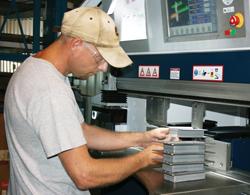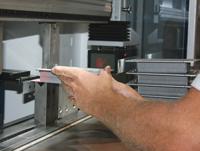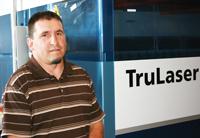Editor-in-Chief
- FMA
- The Fabricator
- FABTECH
- Canadian Metalworking
Categories
- Additive Manufacturing
- Aluminum Welding
- Arc Welding
- Assembly and Joining
- Automation and Robotics
- Bending and Forming
- Consumables
- Cutting and Weld Prep
- Electric Vehicles
- En Español
- Finishing
- Hydroforming
- Laser Cutting
- Laser Welding
- Machining
- Manufacturing Software
- Materials Handling
- Metals/Materials
- Oxyfuel Cutting
- Plasma Cutting
- Power Tools
- Punching and Other Holemaking
- Roll Forming
- Safety
- Sawing
- Shearing
- Shop Management
- Testing and Measuring
- Tube and Pipe Fabrication
- Tube and Pipe Production
- Waterjet Cutting
Industry Directory
Webcasts
Podcasts
FAB 40
Advertise
Subscribe
Account Login
Search
Concentrating on little things leads to big success
Metal Dynamics changes its shop floor dynamics with nontraditional approach to bending
- By Dan Davis
- November 7, 2011
- Article
- Bending and Forming

Figure 1: The TruBend 7036 electric press brake is the perfect tool for bending small parts that used to occupy the capacity of Metal Dynamics’ larger V1700 press brake and its 10-foot-long bed.
This is a whole other world,” said Ted Zuercher, operations manager, Metal Dynamics, Wooster, Ohio. That statement was comparing his current job working in a fabricating job shop with his previous jobs working at a metal service center for seven years and an OEM for four years. He could use that statement to compare Metal Dynamics with others in the fabricating field too. The shop does things its own way—a way that some in fabricating simply don’t get.
The company’s commitment to turning around jobs quickly is something other fab shops find hard to match. Its balance of customers might be considered too risky for others. Finally, the company’s owner, Scott Plance, doesn’t want to grow the business at all costs; he wants to do it on his own terms.
Introduction to Metal Fabricating
Plance was trained as a tool- and diemaker while working for a clutch manufacturer in Wooster in the mid-1980s. After bouncing around for several years, he went to work for MTD at the lawn and garden equipment manufacturer’s tech center in the early 1990s.
Around 1997 MTD looked to jump into the production of commercial landscaping equipment, a growing area of the industry, and established a joint venture with LESCO in Streetsboro, Ohio. Plance led the formation of the facility’s fabrication department. This marked MTD’s first investment in laser cutting, actually a laser/punch combination machine.
“That was really where I got involved in sheet metal fab,” Plance said.
Like so many other fabricators, the next phase of Plance’s evolution as a metal fabricator started in a garage. In 1998 the joint-venture company was experiencing difficulty with one of its suppliers of metal parts. Plance and a partner started welding these parts in a garage at night, which led to another order and then another. In 2000 Plance left the manufacturing OEM and struck out on his own.
In 2003 Plance said he went through a “business divorce” and took over sole operation of the business. That same year he purchased a TRUMPF
TrumaBend C60 press brake and a used TRUMPF TruMatic 500 punching machine. He had experience with TRUMPF machines because that’s what was used in the fabrication department he came from.
“I thought that I was at the point where I was buying enough blanks that I wanted to bring some of that in-house and start doing it myself,” he said.
Only a year later he purchased his first TruMatic L3030 cutting machine. Business “took off” after the purchase, and Plance admitted his timing couldn’t have been any better.

Figure 2: The cycle time to produce parts, such as these small automotive components, has been reduced greatly because the electric press brake’s stroke is much quicker than the hydraulic press brake‘s.
“The nerve-wracking part about it—looking back because, honestly, I was probably blind to it then—was that the cost of that machine was more than our total revenue,” Plance said. “Banks wouldn’t do that now. There’s no way. Back then they were just trying to give it away.”
In 2006 Metal Dynamics moved into a larger facility and added a 3.2-kW TruMatic L3030 laser cutting machine and a 180-ton TrumaBend V1700 with a 120-inch bed length, 24-in. open height, and a four-axis backgauge. Orders filled the machine, culminating in a very successful 2008.
The next year did not hold the same promise.
A little after the start of 2009, the bottom dropped out of the economy. “For six months it was really ugly,” Plance said.
The small team at Metal Dynamics didn’t sit around feeling sorry for themselves. They moved into a new 20,000-square-foot facility in Wooster, Ohio, and worked to strengthen its service to customers.
“We really kept our service up with the small companies even when we were busy,” Plance said. “So in the downturn, they hang around, and they come back.”
That commitment plays a big part in how Metal Dynamics has been able to grow its business in the days since the Great Recession.
Can You Match This Commitment to Turnaround Efficiency?
Metal Dynamics has a simple policy as is relates to customer service: Jobs are turned around in days, not weeks. If the company’s best customers need same-day service, they get it if at all possible.
Plance’s goal is to make it possible. That means the fabrication shop has to have flexibility designed into it and capacity available. When larger OEM customers are shut down for annual maintenance on equipment, those customers shift additional work over to Metal Dynamics; as a result, the shop can’t afford to have fabricating equipment down. Simultaneously it wants to maintain reliable and quick job turnarounds for its other customers, even in the face of the heavier job load.
Plance said that’s always been his philosophy for investing in new equipment. The new fabricating tools are much more efficient and enable him to stay on top of the expanding job opportunities.

Figure 3: To help operators ensure that parts are bent precisely, a laser projects a line of light onto the surface of the metal.
The most recent example is Metal Dynamics’ TRUMPF TruBend 7036 electric press brake (see Figure 1). With the expansion of the business, Plance and his team—now up to 10 employees—were bending plenty of small mild steel parts that required simple, 90-degree bends but held to close tolerances. The older press brake couldn’t hold the tolerances under load. The much larger V1700 could do the job, but operators were occupying the press brake’s 10-ft.-long bed with 1-in. widgets.
“We had to do so many of those, so we knew we had to do something,” Plance said.
By just watching the electric press brake in motion, Plance said he knew it would work for his shop (see Figure 2). He installed the 40-ton press brake with six-axis backgauge and 40-in.-long bed last year.
Plance said the speed of the press brake, with its 11.5-in. open height, is quite noticeable, almost double the ram speed of the bigger press brake.
Shane Simpson, TRUMPF’s TruBend product manager for North America, said the acceleration and deceleration of the ram on the electric press brake is about 3.5 times faster than that of the company’s hydraulic models. The machine doesn’t have to wait for hydraulics to generate pressure. The gearless, direct-drive motor quickly reacts to the control command. The motor has a two-part rotor with a spindle nut that drives the rotational movement and a recirculating ball screw that provides the up-and-down movement associated with the ram. He added that the electric press brake can deliver up to 20 bends per minute, under ideal circumstances, of course.
But ram speed is only one part of the press brake’s high speed. The six-axis backgauge is made of a carbon-fiber material and zips quickly to the next bend in the sequence.
That’s been a big improvement for Metal Dynamics, Plance said. When operators were using the V1700 for these precision bends, they had to create special tabs on parts so that they could work with the press brake’s adjustable backgauge. The CNC backgauge now expedites bending tremendously.
“Sometimes I wish it were a few more inches wider, but just to get all of those small parts off the big press brake is just huge,” Plance said. The V1700 has almost 600,000 strokes on it, and Plance said he believes the new electric press brake will add years of useful life to the older press brake because it’s no longer accruing extra wear bending small parts.
Simpson said early on, when the electric press brake hit the market, the machine’s energy efficiency was the big story. However, the press brake’s productivity features—easy-to-use clamping tools for quick changeout and laser guidance to help ensure quality bends (see Figure 3)—soon overshadowed the machine’s environmentally friendly qualities.
“What they are looking at is 40 percent to 60 percent more productivity [when compared to typical hydraulic press brakes],” Simpson said. “If you are talking about hundreds of thousands of parts, that number is astronomical.”

Figure 4: The electric press brake improved Metal Dynamics’ ability to turn small-part bending jobs more quickly, and a new 6-kW laser cutting machine holds the same potential for parts made from plate. “I kind of felt that laser cutting is what we are known for, and we have to stay up on the technology,” said Scott Plance, Metal Dynamics’ owner.
Plance didn’t have a figure on how much the new bending technology has saved his shop, but he still has his main goal: “We just want to be more efficient because we don’t have a big group here at all.”
He isn’t stopping there (see Figure 4). Metal Dynamics was in the midst of installing a 6-kW TRUMPF laser at the time of the interview. Plance said the laser cutting machine allows the company to cut thicker materials, up to 1 in. on stainless steel, much more quickly. The new laser also keeps the thicker material off his other lasers, which now do what they do best—quickly cut thinner-gauge material.
Would You Go Against the Grain?
Metal Dynamics’ first customer remains its largest today. The relationship is still fruitful for both parties.
In fact, MTD represents a pretty large chunk of the company’s business. That approach makes many fabricators nervous, but Plance said he is going to grab all of the work he can when it becomes available.
“I think I’d be a fool to turn away the work, but I know some people that do it. They won’t take work if it pushes them over 40 percent in a certain sector,” he said. “I’ll take that 80 percent for six months. It’s all a risk.”
Plance is not afraid to go against the grain. For instance, while other companies do their best to stay as far away from the automotive industry as possible, Metal Dynamics has jumped at the opportunity. It has required some investment to bolster the company’s metal fabricating credibility with those automotive customers; Plance hired an engineer with experience in the automotive industry and purchased a FARO coordinate measuring machine to certify parts before shipping and produce ISO-type quality reports.
Metal Dynamics’ existing equipment lineup already delivered the tolerances needed to meet the stringent quality standards of those same automotive customers, Plance said. Because his company has the tools and processes in place to produce automotive parts quickly and correctly—the first time around—he views working with these Tier 1 and Tier 2 automotive suppliers as a low-risk endeavor.
Plance said his employees make it possible for him to make decisions that might make a banker scratch his head. He can rely on them because he knows they are highly skilled and dedicated to producing quality parts, just like he did when he was working in the two-car garage.
“The way I run the shop is letting Ted run it and stay out of the way,” Plance said. “My expectation is that they are here to do a job, and they should be able to do it. I shouldn’t have to stand there and watch them. No one is going to do that. The guys that work here know that and appreciate it.”
Can You Not Get Carried Away Chasing More Revenue?
Plance has worked hard to create that type of environment for the workforce. It all goes back to those early days of his business.
“In the beginning, if something was screwed up, it was always Scott did it,” Plance said. “That’s how I felt. I make sure everyone understands that—the idea of ‘Would I pay for that [out-of-spec part]?’ Of course not.
“That’s something we haven’t lost,” he added. “That makes us very competitive.”
That also means he doesn’t add employees just to accommodate a job opportunity. He recalled the time someone contacted him to use Metal Dynamics’ robotic welding capability for a military part. To land the job, however, Plance said he would have had to hire a certified welding inspector to inspect each weld on the part. That’s an expensive proposition for a company that, first, needs to find that special talent and, second, requires that new hire to be skilled in other areas so he or she can contribute when that military part is not being welded.
Other opportunities have been greeted with the same type of skepticism, especially if it takes the company out of its core laser cutting, bending, and joining activities.
Customers have asked him to take on machining, but that doesn’t appeal to him.
“That’s so cutthroat. And there are so many shops around,” Plance said.
What about adding a finishing line?
“Why would I want to add one other opportunity for error?” he asked.
Satisfaction Guaranteed
Plance recognizes that keeping his formula for success alive is much more important than doubling the company’s $3 million in annual revenues over some sort of five-year plan. He likes the metal fabricating business and doesn’t mind working on the shop floor like everyone else. He’d rather be talking about cutting power than PowerPoints.
“I just want to grow within what we do well,” he said.
In today’s bigger-is-better world, that approach sounds out-of-this-world. It also works well for keeping Metal Dynamics’ attention focused on its customers and not on arbitrary financial goals.
About the Author

Dan Davis
2135 Point Blvd.
Elgin, IL 60123
815-227-8281
Dan Davis is editor-in-chief of The Fabricator, the industry's most widely circulated metal fabricating magazine, and its sister publications, The Tube & Pipe Journal and The Welder. He has been with the publications since April 2002.
Related Companies
subscribe now

The Fabricator is North America's leading magazine for the metal forming and fabricating industry. The magazine delivers the news, technical articles, and case histories that enable fabricators to do their jobs more efficiently. The Fabricator has served the industry since 1970.
start your free subscription- Stay connected from anywhere

Easily access valuable industry resources now with full access to the digital edition of The Fabricator.

Easily access valuable industry resources now with full access to the digital edition of The Welder.

Easily access valuable industry resources now with full access to the digital edition of The Tube and Pipe Journal.
- Podcasting
- Podcast:
- The Fabricator Podcast
- Published:
- 04/16/2024
- Running Time:
- 63:29
In this episode of The Fabricator Podcast, Caleb Chamberlain, co-founder and CEO of OSH Cut, discusses his company’s...
- Trending Articles
AI, machine learning, and the future of metal fabrication

Employee ownership: The best way to ensure engagement

Dynamic Metal blossoms with each passing year

Steel industry reacts to Nucor’s new weekly published HRC price

Metal fabrication management: A guide for new supervisors

- Industry Events
16th Annual Safety Conference
- April 30 - May 1, 2024
- Elgin,
Pipe and Tube Conference
- May 21 - 22, 2024
- Omaha, NE
World-Class Roll Forming Workshop
- June 5 - 6, 2024
- Louisville, KY
Advanced Laser Application Workshop
- June 25 - 27, 2024
- Novi, MI


























